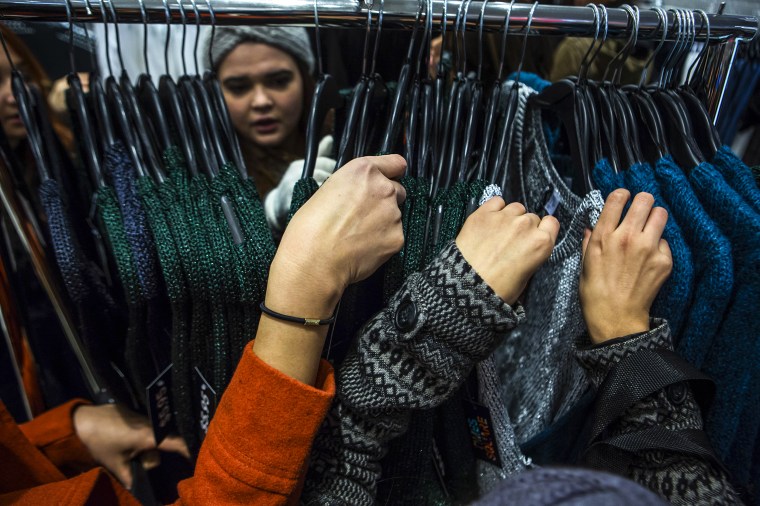You’re not imagining it: Well-made clothing is harder to come by. The U.S. fashion industry is having a hard time maintaining quality standards amid stiff competition from overseas rivals and supply-chain shakeups.
Twenty-seven percent of textile and apparel professionals reported that ensuring consistent quality was “difficult” or “very difficult” over the past year, up from 23% in 2024, according to a recent survey the product auditing firm QIMA provided to NBC News.
“There has been a significant reduction in the quality of the fabric for a number of the major brands and retailers,” said Margaret Bishop, a textile development and marketing professor at the Fashion Institute of Technology in New York. She said the decline intensified during the recovery from the pandemic, when apparel makers scrambled to untangle disrupted supply chains and contended with weak sales during global lockdowns.
The corner-cutting is partly a tradeoff on price — a bet that the fashion industry has placed on inflation-weary shoppers’ willingness to accept lower-quality garments that don’t break the bank. Since 2019, consumer prices overall have risen 26%, food is up 30% and cars are up 25%, but apparel prices have inched just 6% higher.
There has been a significant reduction in the quality of the fabric for a number of the major brands and retailers.
Margaret Bishop, Fashion Institute of Technology
Clothing retailers “know if they raise the price, they lose consumers,” said Sheng Lu, a professor of fashion and apparel studies at the University of Delaware.
While a basic wardrobe of clothing and shoes is essential, households typically approach such purchases as discretionary — nice-to-haves, at least relative to keeping their cars filled with gas and their fridges stocked with milk and eggs. And over the past year, consumers have repeatedly proved to be laser-focused on value, chasing deals and discounts wherever they can find them.
When it comes to garments and footwear, Americans often find the best prices among sellers overseas, including the China-linked e-commerce giants Shein and Temu. The ultracheap foreign retailers have given domestic rivals such a run for their money that they drew a crackdown from the Biden administration, and the Trump administration’s new China tariffs could crimp them further.
China is already the largest exporter of apparel to the United States, and QIMA’s factory inspections found the failure rate, or share of textile and apparel products with too many defects for market, rose to 13.7% last year from 12.7% in 2023. As many apparel brands move more production out of China to reduce their labor costs and exposure to tariffs, they’re gravitating toward countries with even higher failure rates: India’s is 21.2%, Cambodia’s is 16.6%, and Indonesia’s is 14.2%.

“Someone who’s running this factory maybe doesn’t have three decades of experience” in many of the emerging garment production markets, said Joseph Ng, CEO of Shift Fashion Group, a consultancy that works with manufacturers. “It takes a long time to get a large enough workforce to the point where they know what to do exactly.” Those issues are compounded when workers are pushed to generate quantity over quality, he added.
The silver lining is that overall global quality levels have remained relatively flat in recent years, QIMA said, and failure rates in several key manufacturing countries improved noticeably last year.
Nevertheless, the environment spurred “a race to the bottom,” Bishop said, at a time when labor and raw materials costs were rising rapidly.
Demand for both domestic and foreign fast-fashion brands’ low-cost apparel has surged. From 2020 to 2024, the top three global fast-fashion retailers — Shein (based in China), Zara (Spain) and H&M (Sweden) — nearly tripled their U.S. market share, according to data from Euromonitor. Many other domestic fashion brands have struggled to compete, resorting to promotions to prop up sales and cost-cutting to offset the impact on their profit margins.
Fabric accounts for 60% of a garment’s total production cost, Lu estimated, with labor typically clocking in around 30% and trim — zippers, buttons or decorative details — making up the rest. So when retailers look to save money, fabric is one of the first components to get downgraded.
Quality can vary widely even within a single brand’s clothing line, depending on where each of its items is made, Ng said. Large retailers “use buying houses that will actually produce in different regions, producing different products,” he said. That’s one reason a brand might simultaneously produce high-quality, well-fitting T-shirts and shoddy jeans with haphazard stitching.
The biggest misconception when it comes to fashion is that luxury goods and high-end goods mean quality.
Joseph Ng, CEO of Shift Fashion Group
Julia Hughes, president of the U.S. Fashion Industry Association, acknowledged anecdotal reports of quality concerns in a statement but said that “for our members — well-known brands and retailers — they maintain the same or better quality requirements today.”
For shoppers looking for the best bang for their buck, it can make for a frustrating experience. To identify well-made clothing, Bishop recommends taking the time to examine each garment closely in person. Stitching and fabric are two key indicators of overall quality, she said, adding that heavier fabrics tend to be more durable than lightweight ones.
Bishop also suggests holding garments up to the light to check for small holes or uneven yarn tension. Stitches should be tight, with ideally eight stitches per inch. Avoid garments with loosely sewn buttons and fabrics that lose their shape after they’re stretched, she advised.
“There’s a myth that if something’s made from synthetic, it’s bad, it’s cheap,” Bishop said. Nylon is very durable, for example, and polyester is great at wicking sweat.
Ng said: “It’s really about the right application. When it comes to athletic wear, you don’t want cotton leggings.”
He also cautioned that steep prices don’t necessarily signify better craftsmanship.
“The biggest misconception when it comes to fashion is that luxury goods and high-end goods mean quality,” Ng said. He added that “there is a movement starting to happen where consumers want higher-quality clothing.”
Consumers are increasingly valuing repairability, durability and quality, Euromonitor’s market research has found, a trend that coincides with growing interest in secondhand clothing.
The more shoppers are turned off by poorly made, low-cost garments, the more brands have an opportunity to differentiate themselves on “quality and service,” said Marguerite LeRolland, an apparel and footwear industry manager at Euromonitor. That, in turn, can help “justify higher prices and fewer promotions,” she said.








